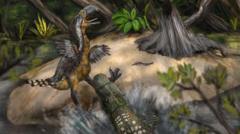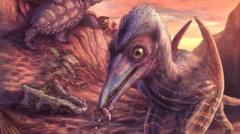The analysis, published in *Biology Letters*, reveals that the terror bird, measuring approximately 2.5 meters tall, likely did not survive the confrontation, as indicated by the lack of healing in the bite marks. The research highlights the importance of paleontological evidence in reconstructing the behavior and vulnerabilities of extinct species, suggesting that these fearsome birds faced significant predatory threats.
The leg bone, originally unearthed in Colombia's fossil-rich Tatacoa Desert over 15 years ago, was carefully assessed by scientists who collaborated with local fossil collector César Augusto Perdomo. The teeth marks were linked to Purussaurus neivensis, an extinct caiman that could grow up to five meters long. This predator would have hunted by ambushing its prey from water, similar to contemporary crocodilians.
This study underscores the significance of such fossil finds, as they enrich our understanding of prehistoric life and the dynamics of ancient ecosystems. Lead researcher Andres Link posits that every fragment adds valuable insights into the past, transforming our comprehension of historical biotic relationships between species.
Paleontologists hope to continue unraveling the complexities of prehistoric interactions and the evolutionary paths of these remarkable beings that roamed the Earth millions of years ago.
Fossils offer profound insights into past ecosystems, revealing the fierce competition and vibrant life that once characterized our planet millions of years ago.
The leg bone, originally unearthed in Colombia's fossil-rich Tatacoa Desert over 15 years ago, was carefully assessed by scientists who collaborated with local fossil collector César Augusto Perdomo. The teeth marks were linked to Purussaurus neivensis, an extinct caiman that could grow up to five meters long. This predator would have hunted by ambushing its prey from water, similar to contemporary crocodilians.
This study underscores the significance of such fossil finds, as they enrich our understanding of prehistoric life and the dynamics of ancient ecosystems. Lead researcher Andres Link posits that every fragment adds valuable insights into the past, transforming our comprehension of historical biotic relationships between species.
Paleontologists hope to continue unraveling the complexities of prehistoric interactions and the evolutionary paths of these remarkable beings that roamed the Earth millions of years ago.
Fossils offer profound insights into past ecosystems, revealing the fierce competition and vibrant life that once characterized our planet millions of years ago.


















